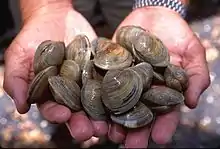
The quahog parasite unknown, or QPX, is a single-celled protist parasite in the class Labyrinthulomycota that affects hard clams (Mercenaria mercenaria; quahogs),[1] both cultured and wild.[2]
Parasites similar to QPX were first observed in New Brunswick, Canada, in 1959, when a mass death of hard clams was observed. Outbreaks have also occurred in Nova Scotia, Prince Edward Island, New York, New Jersey, Massachusetts, and Virginia, always only in quahog clams.[1][3]
Symptoms of QPX include chipping of the shells, mantle swelling, stunted shell growth and the development of nodules.[3][2]
Biology
The life stages of thalli, endospores, and sporangia have been observed.[3] It somewhat resembles the unrelated protist haplosporidian parasite Haplosporidium nelsoni (MPX), a pathogen of the eastern oyster.[2]
QPX was originally considered a chytrid, but has now been provisionally assigned to the phylum Labyrinthulomycota in either the families Thraustochytriidae or Labyrinthulidae, based on the organism having a "uninucleate biflagellate zoospore stage, a loose multilaminar cell wall, and particularly an intracellular sagenogen-like structure".[4] However, much about it is still unknown.[1] QPX-like organisms also may not be all of the same species.[2]
Molecular phylogenetic on the SSU rRNA of QPX was able to produce the same phylum-level identification, and more precisely down to the family Thraustochytriidae next to Thraustochytrium pachydermum. A PCR primer targeting this region that detects QPX infection has been constructed.[5]
QPX can be cultured in laboratories, with the optimal temperature being 20 to 23 °C. It produces a mucus that causes inflammation in the clam and shields itself from clam immune response.[6]
Control and epidemiology
Genetics
The partial genome of QPX has been sequenced by the shotgun method in 2013, along with the transcriptome to identify genes important in stress response (mainly temperature). A few interesting proteins and a wide range of genetic polymorphisms have been identified. It expresses some genes involved in the synthesis of antibiotics that are also toxic to clams.[6] Further experimental characterisation in 2018 of these single-nucleotide polymorphisms shows variations in genes related to virulence and environmental (salinity and temperature) adaptation.[7]
References
- 1 2 3 Ragone Calvo, L.M.; Walker, J.G.; Burreson, E.M. (Jul 30, 1998). "Prevalence and distribution of QPX, Quahog Parasite Unknown, in hard clams Mercenaria mercenaria in Virginia, USA" (PDF). Diseases of Aquatic Organisms. 33 (3): 209–19. doi:10.3354/dao033209. PMID 9745718.
- 1 2 3 4 Coen, Loren; Bobo, M. Yvonne; Richardson, Donnia; Anderson, Willam D. "Sheet for QPX (Quahog Parasite Unknown)" (PDF). Retrieved 3 January 2017.
- 1 2 3 "QPX Disease in Hard Clams" (PDF). Sea Grant New York. Retrieved 30 October 2016.
- ↑ Ragan, Mark A.; MacCallum, Greg S.; Murphy, Colleen A.; Cannone, Jamie J.; Gutell, Robin R.; McGladdery, Sharon E. (28 September 2000). "Protistan parasite QPX of hard-shell clam Mercenaria mercenaria is a member of Labyrinthulomycota" (PDF). Diseases of Aquatic Organisms. 42 (3): 185–90. doi:10.3354/dao042185. PMID 11104069. Retrieved 31 October 2016.
- ↑ Stokes, NA; Ragone Calvo, LM; Reece, KS; Burreson, EM (2002). "Molecular diagnostics, field validation, and phylogenetic analysis of Quahog Parasite Unknown (QPX), a pathogen of the hard clam Mercenaria mercenaria". Diseases of Aquatic Organisms. 52 (3): 233–247. doi:10.3354/dao052233. PMID 12553451.
- 1 2 Garcia-Vedrenne, Ana Elisa; Groner, Maya; Page-Karjian, Annie; Siegmund, Gregor-Fausto; Singhal, Sonia; Sziklay, Jamie; Roberts, Steven; Benos, Panayiotis V. (17 September 2013). "Development of Genomic Resources for a thraustochytrid Pathogen and Investigation of Temperature Influences on Gene Expression". PLOS ONE. 8 (9): e74196. Bibcode:2013PLoSO...874196G. doi:10.1371/journal.pone.0074196. PMC 3775781. PMID 24069279.
- ↑ Bassim, Sleiman; Allam, Bassem (20 June 2018). "SNP hot-spots in the clam parasite QPX". BMC Genomics. 19 (1): 486. doi:10.1186/s12864-018-4866-8. PMC 6011583. PMID 29925308.